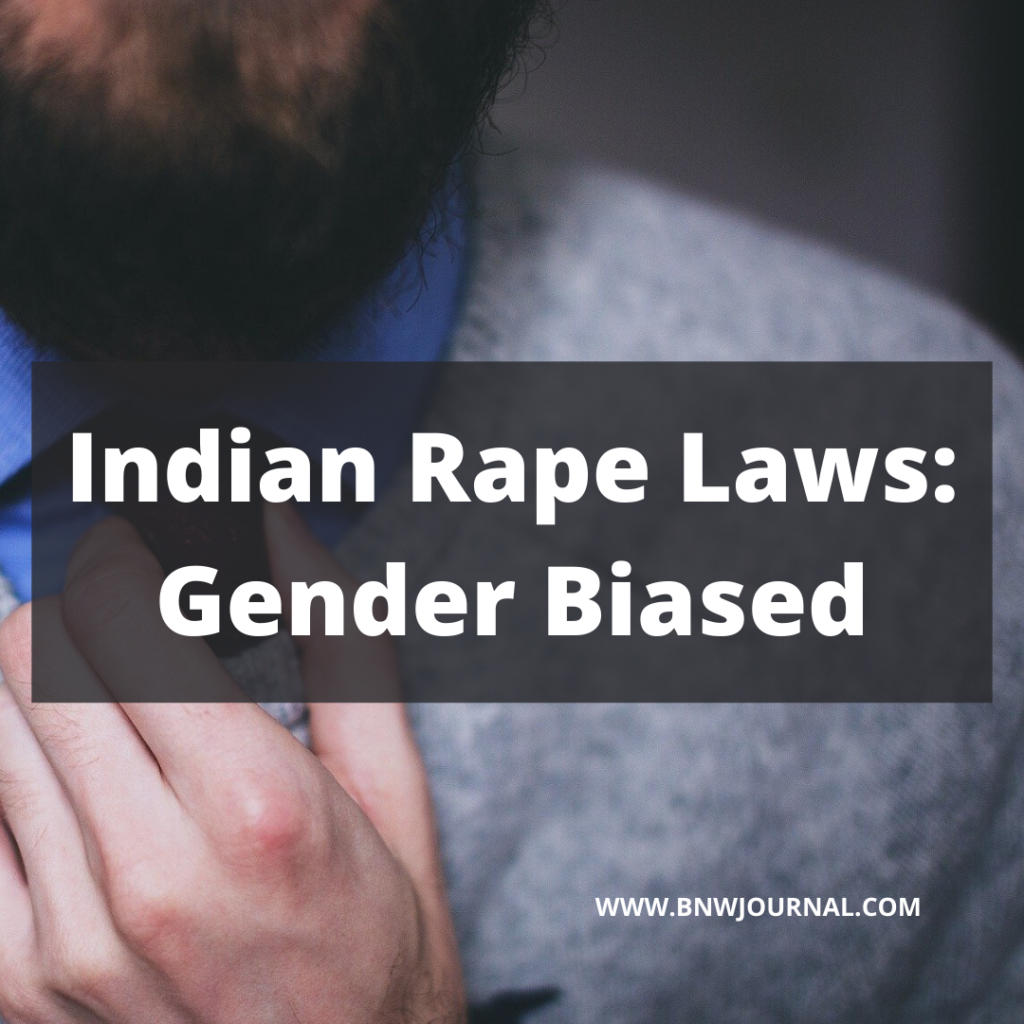![]()
Introduction
India has been dealing with crime against women for a long time. Several Indian laws have recognized violence against women in every form with proper provisions of strict punishment. However, the culprits or perpetrators in these laws are pre-determined as males, which make these laws gender-biased and also violating the fundamental right to equality.

Indian law is based on the notion that a rape victim can only be a woman. This arises from the assumption that rape is an act of sex only which satisfies the perpetrator’s sexual desire. However, there is a growing perception that sexual assault is not only an act of lust and desire. But it is also used to exert dominance or superiority of one caste, class, religion. Also the community over the other and are sheer acts of power and humiliation. If it is regard; so then there is no reason as to why the male gender and transgender cannot be rape victims.
New technologies and developments are making the world fast and advanced. However, in case of mindset, we still do lack behind. India and several other countries are yet to recognise sexual assault or rape on men. It is a fact that even men face sexual assault and rape. The problem has increase ten-fold today and most of the cases go unreporte.
Despite the expansion of the definition of rape under the Indian Penal Code, 1860 (IPC) to include non-penile vaginal acts of penetration. The said law continues to conform to a specific gender. The notion of rape in India is predetermined and the characterization of victims or perpetrators is done based on gender.
We must adopt a “human right” approach in defining the offence and negating the role of gender in identifying the perpetrators or victims of rape.
Indian Rape Laws: Gender Biased
Section 375 and 376 of the Indian Penal Code, 1860 defines rape. According to the section only a man can be convict of committing rape. The victim can only be a woman. Further, the other laws relating to crime against woman like Stalking (Section 354D), Sexual harassment (Section 354A), Voyeurism (Section 354C) are gender-specific. The gender of the perpetrator and victim both are pre-determine.
To make the provisions Section 375, 376 of the Indian Penal Code. They need to be entirely re-write to make them neutral or are deem to be understood differently. If it is concede that men can be victims of rape whether by women or other men.
After Nirbhaya’s gang rape of 2012, there was a change in the rape laws. The incident saw an increase in national attention towards the crime of rape. The male rape survivors then also began to speak out, including a Chennai based man’s blog post which went viral.
A social activist, Sanjiv Kumar filed a petition before Delhi High Court seeking gender-neutral rape law. A bench of the then acting Chief Justice of Delhi High Court Gita Mittal and Justice C Hari Shankar sent a notice to Central Government. It is to seek a reply on the issue. The centre replied that Gender-neutral rape laws can’t be made as women are predominant victims.
Even before the petition by Sanjiv Kumar, the Supreme Court had dismissed a Public Interest Litigation (PIL) with similar prayers. The PIL challenge the constitutional validity of sections 354 (assault or criminal force to woman with intent to outrage her modesty), 354A (Sexual harassment), 354B (Assault or use of criminal force to woman with intent to disrobe), 354C (Voyeurism), 354D (stalking) and 375 (Rape) of the Indian Penal Code. The PIL argue that since these provisions do not protect men from sexual violence. Also the male or female perpetrators go unprosecute. Thus they are in violation with Article 14 (Equality before Law). Also Article 15(Prohibition of discrimination on grounds of religion, race, caste, sex or place of birth).
A bench head by the then Chief Justice Dipak Misra terme it as an “imaginative petition”. He further note that the sections of Indian Penal Code are approve provisions for the protection of women. The classifications of the sections are valid.
The Law Commission in its 172nd Report submit in the year 2000 recommend that; the definition of rape should be made gender-neutral. It recommended the replacement of the term “rape” with the word “sexual assault” in the Indian Penal Code.
The recommendations of the commission never saw the daylight until 2012 when the Criminal Law (Amendment) Bill, 2012 proposed a gender-neutral definition of rape. Before the 2012 bill could be passed the nation was shocked by the gang rape of Nirbhaya. The legislature form the Justice Verma Committee in order to look into amending the criminal law. In order to provide quicker trials and more strict and enhance punishment for committing sexual assault of extreme nature on women.
Contradictory to the 2012 bill, the Justice Verma Committee recommend that the offence “rape” should not be substituted by “sexual assault”. The committee also recommend that the offence be gender-neutral. But only from the perspective of the victim while the perpetrator remains to be a male.
Despite being well-receive, the recommendation did not result in the desire change. The following criticism from women rights activists and eminent female scholars. For instance, in her opening statement to the Justice Verma Committee. Ms Indira Jaising, a prominent Senior Advocate in India label the move as unacceptable. Since rape was to be always characterize as a crime constitutive of patriarchy and thus gendered.
The Criminal Law (Amendment) Ordinance, 2013 which adopt a rather gender-neutral definition of rape was also revert subject to immense criticism. The legislature readjust its stance after a few months being compell to criticism earlier.
In the next parliamentary session, the legislature enacted the Criminal Law (Amendment) Act, 2013 to supersede the ordinance promulgate earlier and returne to the gender-specific definition of rape which is presently in effect.
In July last year Senior Advocate and parliamentarian KTS Tulsi introduced a private members bill before the Rajya Sabha for amending criminal laws to make sexual offences gender-neutral. However, there has been no progress in that regard since then.
The Protection of Children from Sexual Offences (POCSO) Act, 2012 recognises gender-neutral rights, thus boys under the age of 18 are protect against sexual assaults but once they pass the age they are “rob of their rights”. In this regard, the Indian Government did a survey in 2007. They find out that, out of the survey children who report to have experience severe sexual abuse. It include rape, 57.3% were boys and 42.7% were girls. Also India Dariwala, founder of The Hands of Hope Foundation who investigate finding unresolve Male trauma and its effects on the afterlife. Through an online survey on 160 Indian she find out that 71% of them had been sexually abuse as a child.
The problem does not lie for the males and children only but also transgender. The return of rape to a gender-specific definition in 2013 met with criticism from the LGBTQ community as well. It was point out that the current laws left the transgender persons with no clear remedy in case of sexual violence. For instance, a 19-year-old transgender was beat and gang-rape by 4 men in Pune in 2017. The accuse were book under Section 377 (unnatural offences), 323(voluntarily causing hurt), 504(intentional insult with intent to provoke breach of peace) and 506 (punishment for criminal intimidation) of the Indian Penal Code. The Trial Court found all the accused innocent as Section 377 did not have any mention about the third gender back then.
However, following the judgement by a 5 judge bench in Navtej Singh Johar v. Union of India (AIR 2018 SC 4321) which recognised “Third Gender” and the court unanimously declared the law unconstitutional “in so far as it criminalises consensual sexual conduct between adults of the same sex”
In a survey conduct by the Delhi base Centre for Civil Society found that approximately 18% of Indian men report being coerce to have sex, of that 16% claim a female perpetrator and 2% a male perpetrator.
Thus, the laws need amendment and they need to be consider from the perspective of a male or transgender as well. It is not only the females who suffer sexual violence, the male or transgender can be too and at the same time, the perpetrator should not be gender-specific. As mentioned earlier, the cases of rape of men or transgender do not make into the news because most of them go unreported.
Conclusion
The sad part is that by Masculine Gender socialization it is thought that male cannot be victims of rape. Male on male rape has been heavily stigmatize. Social stigma, “macho man” stereotypes and homophobia all contribute towards boys or men being less likely to report sexual abuse they suffer. There are burdens place on male survivors such as being perceive as effeminate pr perhaps even homosexual. Rape on male still works as a taboo. Male sexual abuse or rape is a largely hidden crisis which needs more attention but in a properly control manner thus barring its misuse. Gender norms compound the trauma for men who are victims of rape and sexual abuse. It is time to give them support.



0 Comments